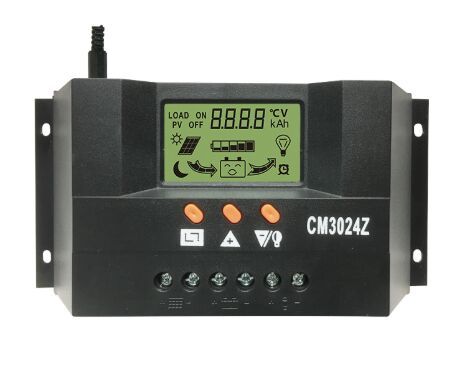The 10A solar controller is a device used to control the photovoltaic panel to charge the battery and provide load control voltage for voltage-sensitive equipment. It regulates and controls the charging and discharging conditions of the battery, and controls the power output of the solar cell components and the battery to the load according to the power demand of the load. It is the core control part of the entire photovoltaic power supply system.
The solar controller uses a high-speed CPU microprocessor and a high-precision A/0 analog-to-digital converter. It is a microcomputer data acquisition and monitoring control system. It not only can quickly collect the current working status of the photovoltaic system in real-time, obtain the working information of the PV station at any time, but also accumulate the historical data of the PV station in detail, which provides accurate and accurate results for evaluating the rationality of the PV system design and inspecting the reliability of the quality of system components. Sufficient basis.
In addition, the 10A solar controller also has a serial communication data transmission function, which can centrally manage and remotely control multiple photovoltaic system substations.
10A solar controller
Photovoltaic controllers are specially designed for solar independent power generation systems. They are mainly used in systems where the load requires light control, time-control, or a combination of light control and time to automatically control the switch.
The charging mode of the conventional 10A solar controller is to copy the three-stage charging method of the mains charger, namely the three stages of constant current, constant voltage, and floating charge. Because the energy of the mains power grid is infinite, if the constant current charging is not carried out, it will directly cause the battery to explode and damage, but the solar street light system has limited battery power, so it is not necessary to continue to use the constant current charging method of the mains controller Scientifically, if the current generated by the battery panel is greater than the current limited by the first stage of the controller, then the charging efficiency will drop.
By detecting the voltage of the battery and calculating the temperature compensation value, when the voltage of the battery is close to the peak value, the pulse-type trickle charging method is adopted to not only make the battery full but also prevent the battery from overcharging.
Overcharge protection: When the charging voltage is higher than the protection voltage, the battery will be automatically turned off to charge the battery. After that, when the voltage drops to the maintaining voltage, the battery will enter the floating charge state. When the voltage is lower than the recovery voltage, the float charge will be closed and enter the equal charge state.
Over-discharge protection: When the battery voltage is lower than the protection voltage, the controller automatically turns off the output to protect the battery from damage; when the battery is recharged, it can automatically restore power.
Load over-current and short-circuit protection: After the load current exceeds 10A or the load is short-circuited, the fuse is blown, and it can be used after replacement.
Overvoltage protection: When the voltage is too high, the output is automatically turned off to protect the electrical appliances from damage.

With anti-reverse charging function: Schottky diodes are used to prevent the battery from charging the solar cell.
With lightning protection function: when there is a lightning strike, the varistor can prevent lightning strikes and protect the controller from damage.
Solar battery reverses connection protection: solar battery "+" "-" polarity connection is reversed, it can be used continuously after correction.
Battery reverse connection protection: battery "+" and "-" polarity connection is reversed, the fuse is blown, and it can be used after replacement
Battery open circuit protection: In case the battery is open circuit, if the solar battery is charging normally, the controller will limit the voltage at both ends of the load to ensure that the load is not damaged. If at night or when the solar battery is not charging, the controller will have Without power, there will be no action.
With temperature compensation function. Self-inspection: When the controller is affected by natural factors or improper operation, you can let the controller self-inspect, let people know whether the controller is in good condition, reduce a lot of unnecessary man-hours, and create conditions for winning the quality of the project and the construction period.
Recovery interval: It is the recovery interval for overcharge or over-discharge protection to avoid the load's work movement caused by the line resistance or the self-recovery characteristics of the battery.
Temperature compensation: monitor the temperature of the battery, and correct the charging and discharging value to make the battery work in an ideal state.